Insights
New research from Sinch reveals the state of customer communications
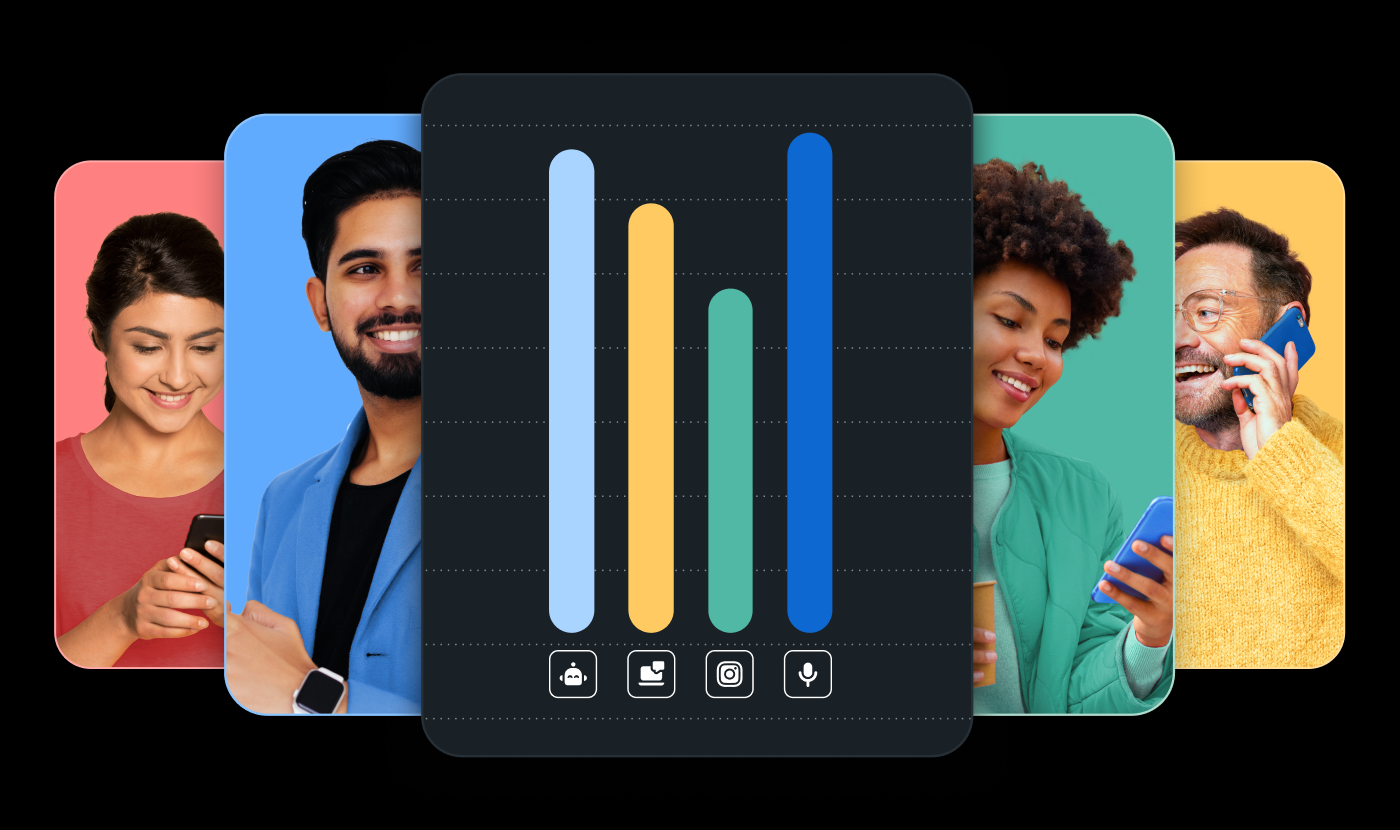
Insights

Keeping up with emerging customer communication channels, advances in technology, and consumer expectations is daunting (that’s putting it mildly). But you don’t have to take our word for it.
Sinch surveyed consumers around the world as well as business leaders from healthcare, technology, retail, and financial services as part of an ambitious research project that’s launching soon.
Here are some of the key takeaways from Sinch’s new report The state of customer communications.
At Sinch, we believe in the idea that strong customer communications are built on four foundational pillars. A cohesive communication strategy should keep people engaged, informed, safe, and happy. These pillars apply to every type of industry, individual businesses, and the overall customer experience.
Here’s how the four pillars of customer communications work:
Of course, there can also be overlap in all four of these areas. That’s just one reason why staying on top of customer communications quickly gets complicated.
Note: In January 2025, Sinch surveyed 2,800 consumers from 12 countries as well as 1,600 business leaders in retail, healthcare, technology, and financial services (FinServ). Results reveal both consumer expectations, frustrations, and preferences as well as business challenges and strategic plans for customer communications in the next year.
Explore some of the key insights from the findings below.
We surveyed more than 1,600 business leaders from healthcare, technology, retail, and financial services (FinServ) to find out about their customer communication strategies. That includes the challenges businesses face in 2025 and beyond.
Across the four industries we surveyed, when asked to select all options that applied, these are seen as the three biggest challenges:
chose security and privacy as a top communication challenge.
chose cost as a top communication challenge.
chose integration with other systems as a top challenge.

While cost and security are concerns in many aspects of a business, integration is somewhat unique to customer communication challenges.
Our research found that 55% of businesses we questioned claim that customer communications are fully integrated with their tech stack. However, that leaves 45% whose communications are only partially or minimally integrated with other systems. That technology includes everything from CRMs and ERPs to core banking systems (CBS) in financial services and electronic medical record (EMR) systems in healthcare.
When you have a partner that provides easy-to-implement messaging APIs or a collection of reliable integrations with leading technology platforms, connecting customer communications becomes much easier.
Beyond those top three challenges, it’s clear that organizations face a wide variety of customer communication concerns. Every challenge presented in our survey was chosen more than 25% of the time. That means one out of every four businesses faces at least one of these challenges.
Sinch also asked business respondents about their plans for communication advancements in 2025. That includes the possibility of adopting new channels to enhance and improve connections with customers.
Two emerging channels of particular interest are Rich Communications Services (RCS) and the use of artificial intelligence, including chatbots and voice bots.
RCS is poised to revolutionize customer communications by delivering a trustworthy, app-like experience to the native messaging application on recipients’ smartphones. More than 80% of all industry survey respondents were at least somewhat familiar with RCS. If it’s new to you, be sure to check out Sinch’s RCS Hub to get answers and see how it works for yourself.
Among those familiar with RCS, many believe it’s a pretty big deal. Sinch’s survey found 59% of respondents call RCS “game changing” for customer communication in their industries. Another 32% think RCS will be useful even if it isn’t essential. Only 1% aren’t interested in RCS.

Sinch’s full report, The state of customer communications, will explore exactly why many business leaders believe they’ll benefit from RCS for Business. To put it simply, RCS messaging is an excellent way to keep customers engaged, informed, safe, and happy throughout the customer journey.
“One of the cool things about RCS is that you can do so much with it. A lot of businesses start with fairly simple messages, by converting their existing SMS over. That works well for improving security with the sender verifications, the branding, and the delivery receipts. And once you start seeing it working, you start to move on to more advanced use cases.”

Wherever you look, there’s tremendous momentum and excitement around the potential for AI to change the way we live, work, and communicate.
Sinch’s research found that 97% of all industry respondents we surveyed are already using or plan to use AI in communication. Plus, AI solutions are among the top channels in which businesses plan to invest over the next year. 63% plan to adopt AI voice assistants while 46% will introduce AI-powered chatbots into the mix.
It’s also clear that many business leaders understand the need to move forward carefully and strategically with AI-powered solutions.
These are their three biggest concerns with using AI in communications:
are concerned with data privacy and security when using AI.
are concerned about accuracy and reliability of AI in communication.
are concerned with customer trust and perception of AI.
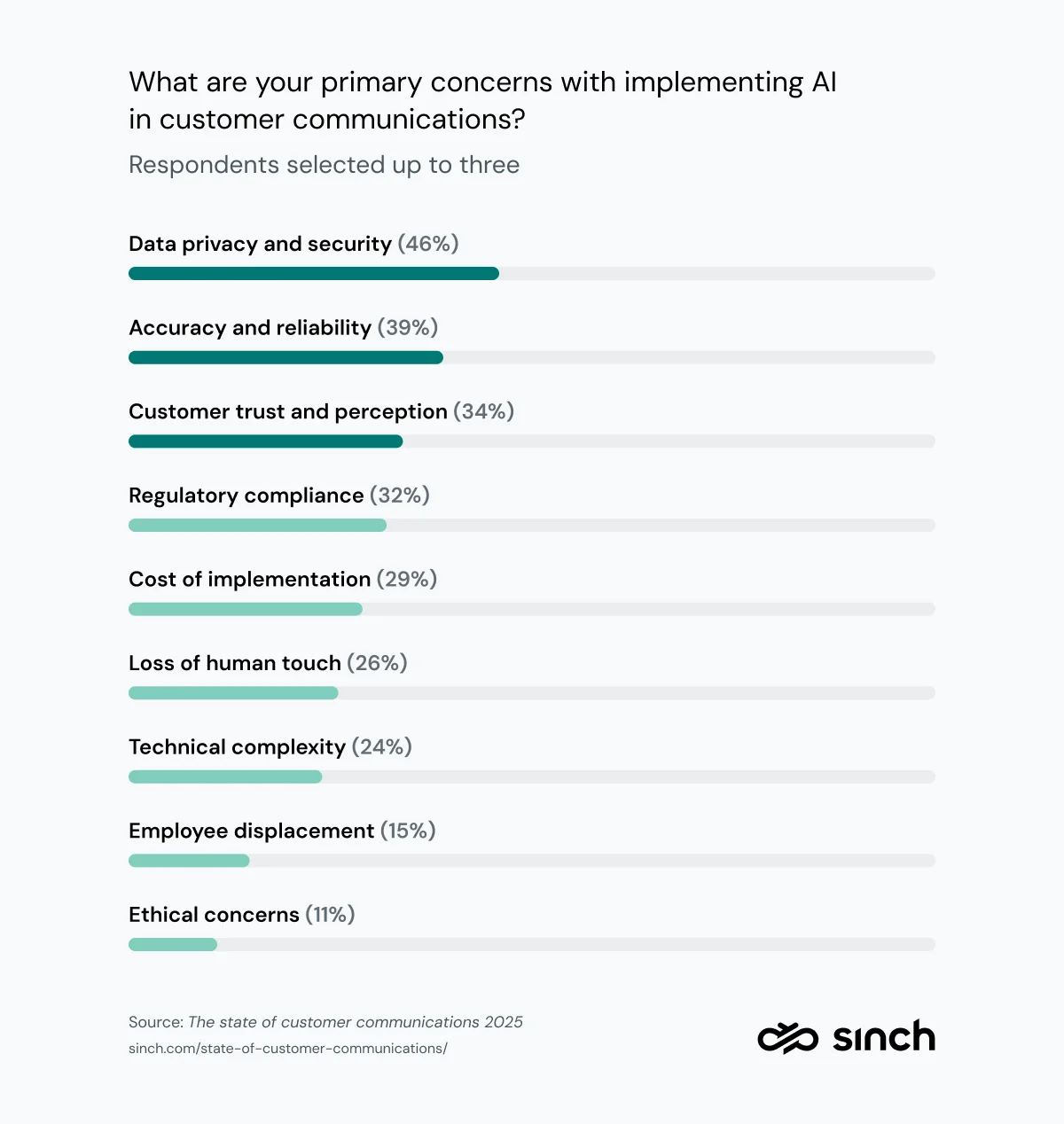
Businesses of all types and sizes stand to benefit from taking advantage of AI in customer communication. Yet it’s wise to keep in mind that consumers may have their own reservations.
The full version of The state of customer communications takes a deeper dive into how AI is being used and how consumers feel about using it. (Hint: Younger generations are much more comfortable interacting with artificial intelligence.)
Speaking of consumers, let’s check out some key takeaways from Sinch’s research around their preferences and pain points. We surveyed 2,800 people of all ages from across the globe to uncover their expectations and frustrations around the four pillars of customer communication.
Beginning with the engaged pillar, here’s what consumers say can go wrong with marketing communications…
Our survey found these are the top three frustrations when receiving promotions from a brand:
of consumers are frustrated by frequent or excessive promotions
of consumers are frustrated when getting messages they didn’t ask to receive.
of consumers are frustrated by irrelevant promotions from brands.
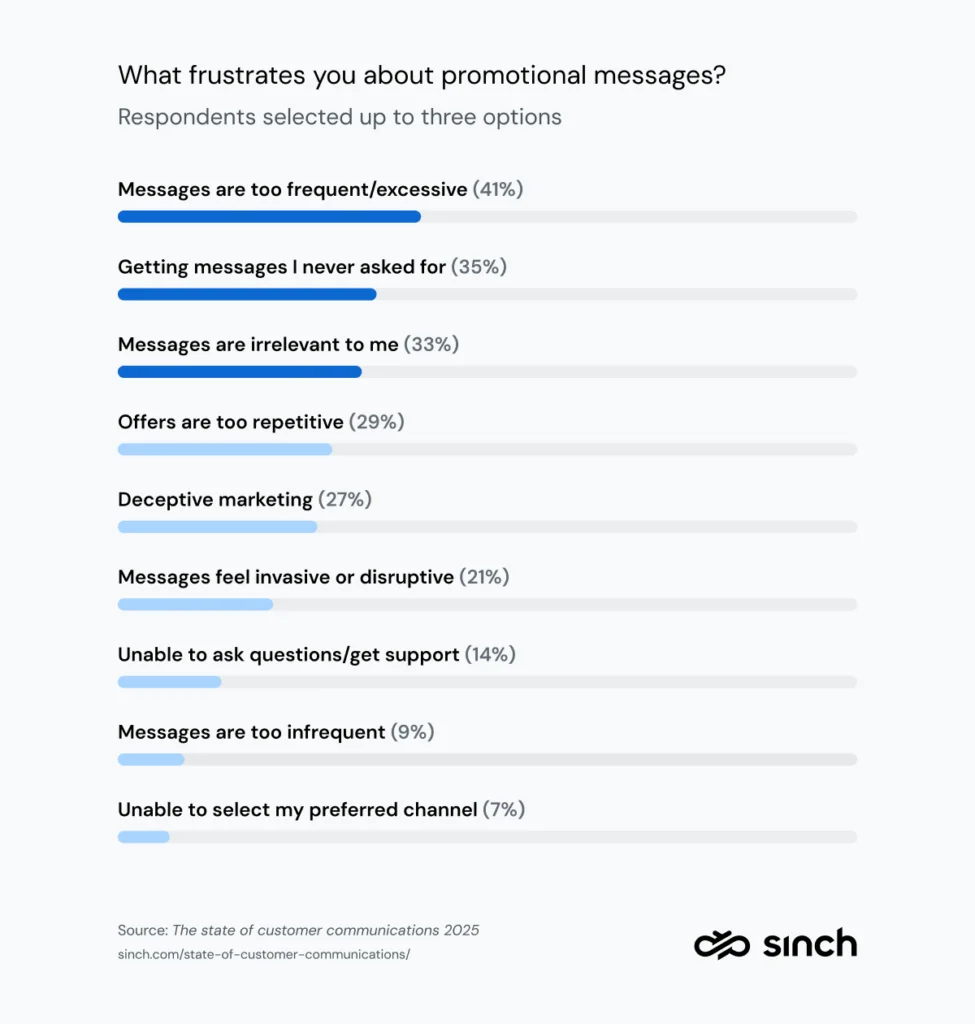
It should come as no surprise that most consumers get annoyed with all the noise that promotions produce in their inboxes.
Unfortunately, too many brands continue to deliver unwanted and irrelevant campaigns while others keep sending until they’re marked as spam. In the full report, we take a look at what consumers are more likely to find engaging. That includes the ways they expect brands to personalize marketing messages.
“Ultimately, what you want to do is make sure you deliver a very personalized experience to your customers, and you’re able to convert that demand on whatever digital communication channels you’re using. Retailers, for example, should consider developing personalized experiences with RCS. I think what’s most impactful is we’re seeing that increases in conversion rates with RCS for Business are huge.”

Customer updates are important. People anticipate them. The messages contain relevant information. And unlike marketing communications, they’re meant for individuals – not mass messaging – which makes them personal.
However, it’s possible to over inform or under inform your customer base. When we asked consumers to tell us what frustrates them about this kind of communication, these were the top three pain points:
of consumers cited updates that were too frequent or excessive.
of consumers are frustrated with redundant informational updates.
of consumers feel frustrated when they’re unable to ask questions or get support.
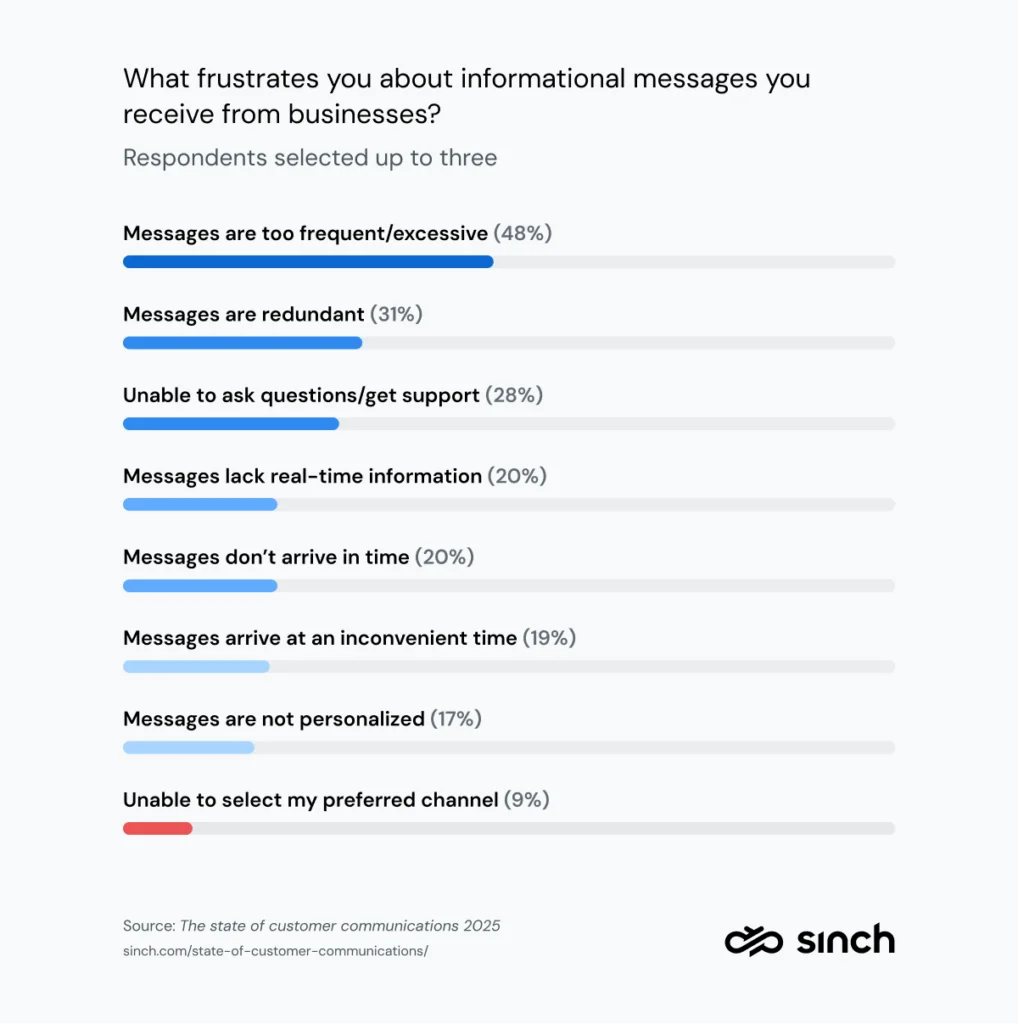
If a customer is inundated with repetitive notifications, these messages cross the line between helpful and annoying. Likewise, when updates fail to arrive on time, lack real-time info, or offer no way to follow up with questions – they’re not really keeping people informed as they should.
The bottom line is that automated customer updates are easy to take for granted, but they are a crucial part of the customer experience that deserves careful attention. Striking the right balance not only keeps customers informed, but it can keep them engaged, safe, and happy as well.
The digital world can be a dangerous place. What is your business doing to protect your customers from bad actors who are trying to trick them with phishing messages?
The truth is that many consumers may be a little too trusting of the messages that arrive in their email and text messaging inboxes. When we asked consumers to choose the channel they believe is least likely to be used for phishing, email (35%) was the most popular answer.
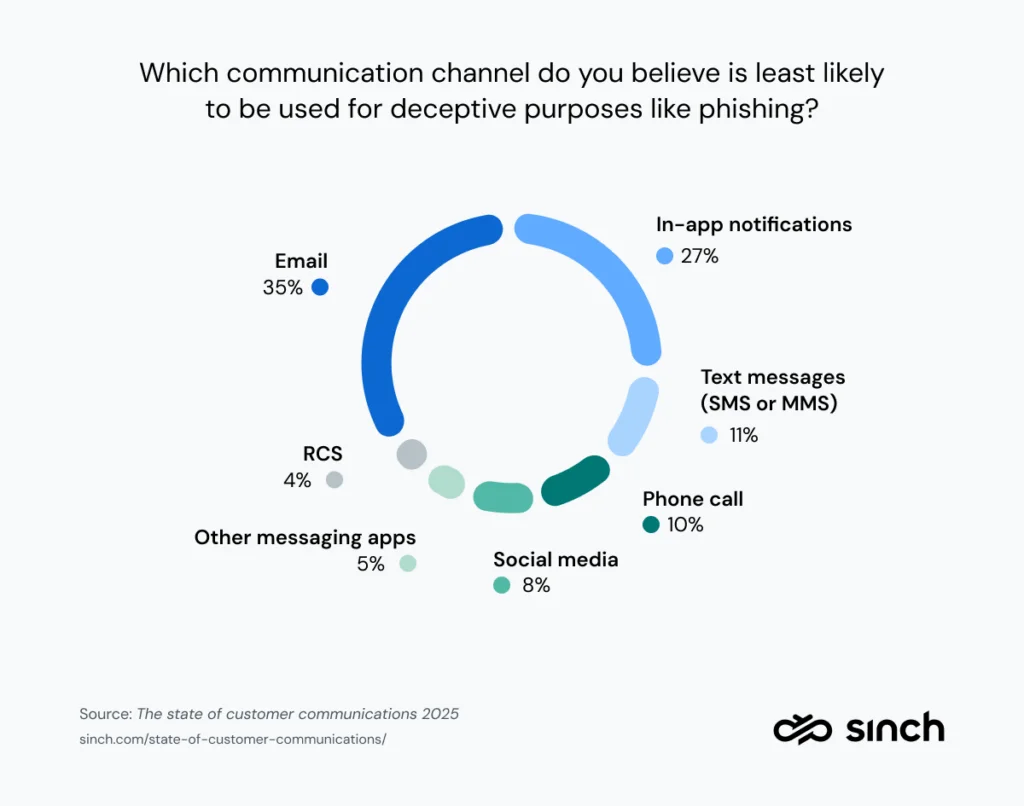
The reality? Email is a very popular threat vector for bad actors looking to steal consumers’ identities. In-app messages (chosen by 27%) may certainly be more trustworthy, but those are only available once a user is logged in to the application.
One-time passwords (OTPs) and various forms of multifactor authentication (MFA) are an important line of defense against malicious messages. They include SMS and emails as well as flash calls that help verify the identity of a user before allowing account access.
While these account protection measures do require additional steps, Sinch’s research found most consumers say OTPs and MFA make them feel safer and are necessary. With a verification API, you can deliver messages that keep people safe on whatever channels your customers prefer.
Messages that are engaging, informative, and trustworthy can all lead to happier customers. But an irreplaceable part of the customer experience occurs when people need support.
Interactions that consumers have with customer service and support can make or break their opinion of your company.
When trying to resolve a problem, consumers often find themselves switching communication channels or being transferred between agents. This can lead to plenty of waiting and repeating, which tries your customers’ patience.
Sinch’s research found that 42% of consumers find this experience frustrating. Another 24% say it wasted their time and 15% lose trust in businesses that can’t keep track of information during support interactions.
Combined, this means 80% of consumers will have a negative reaction. That’s obviously not how you keep customers happy.
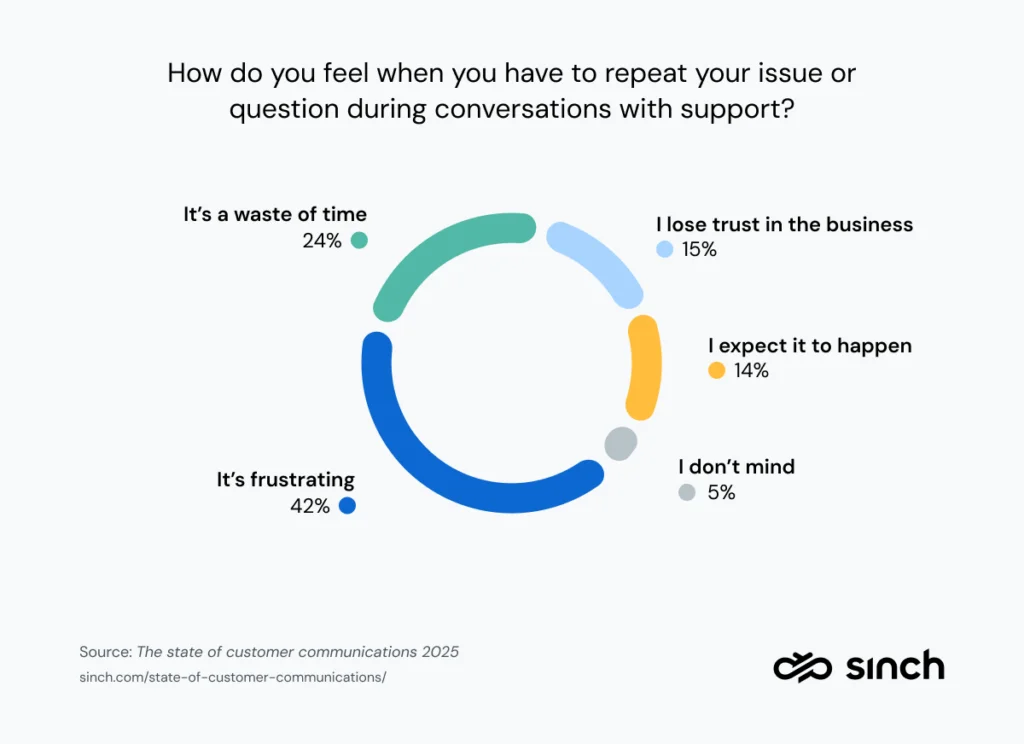
Centralized systems to manage support conversations are essential to a streamlined and satisfactory customer experience. That could mean integrating customer communications with existing platforms or using a communication platform as a service (CPaaS) solution.
For example, Sinch’s Contact Pro is an omnichannel support center that allows you to work with customers via SMS, email, mobile messaging, phone calls, and web chats in one place. This allows your team to keep track of customer interactions during the conversation. It also provides interaction histories for individual customers.
Artificial intelligence solutions are already vastly improving efficiency in customer support. Sinch’s full report explores how consumers feel about using AI in a variety of situations.
“Consumers have become more and more demanding. Generative AI in communications enables companies to leverage their insights and information to instantaneously answer customers. I think compared to where we are today, in terms of customer care and customer service use cases, we’re going to start to see AI handle 10 times the volume that it’s already handling today.”

Sinch’s complete findings from our research are now available. Check out The state of customer communications to read the full report and keep an eye on our blog, social channels, and your inbox for even more customer communication insights.
In the coming months, we’ll also be releasing industry-based reports and articles as well as other content to help you develop and enhance your organization’s communication strategy.
Want to see how businesses across healthcare, technology, retail, financial services, and other industries are finding success through better customer communication? Check out Sinch’s growing collection of customer stories and find out for yourself.